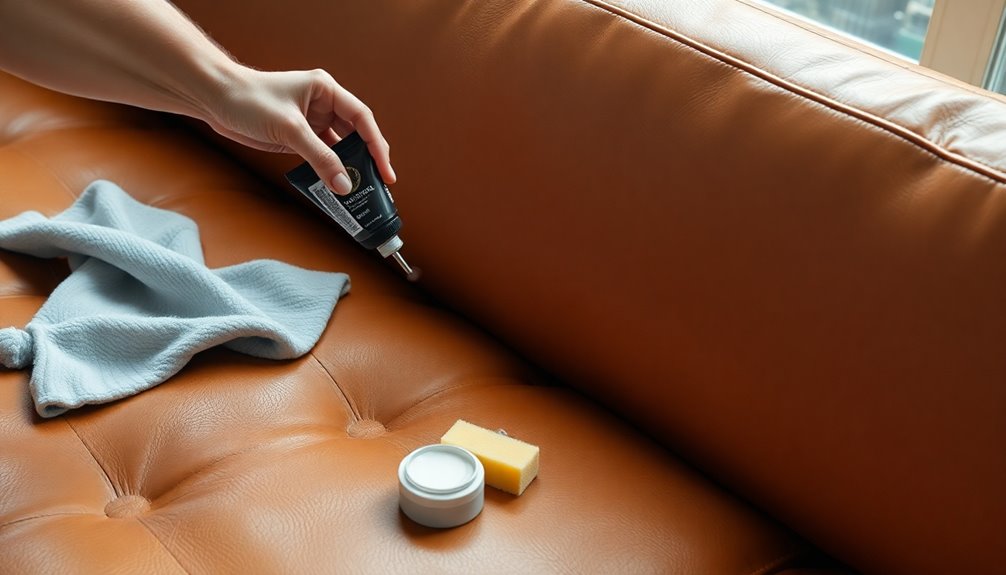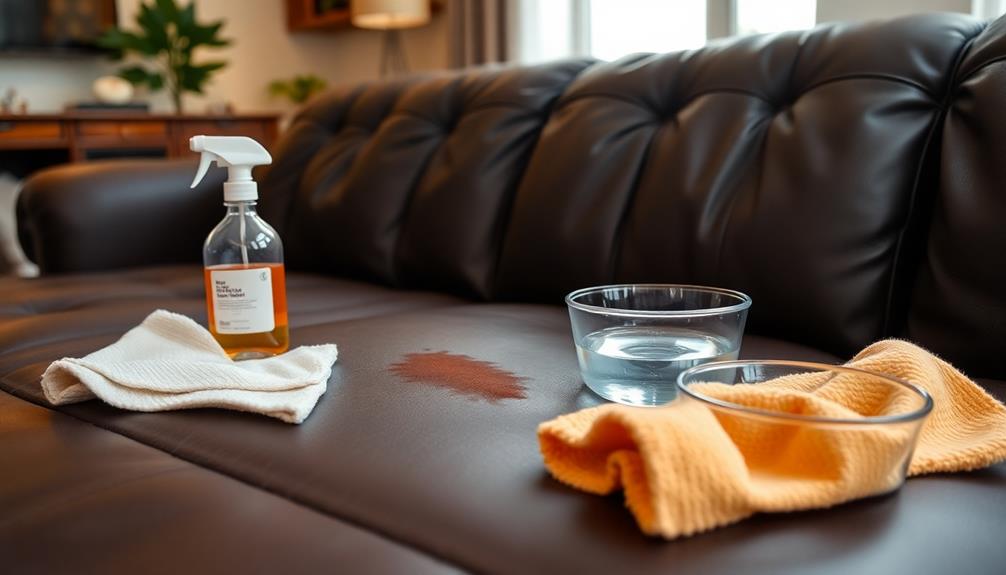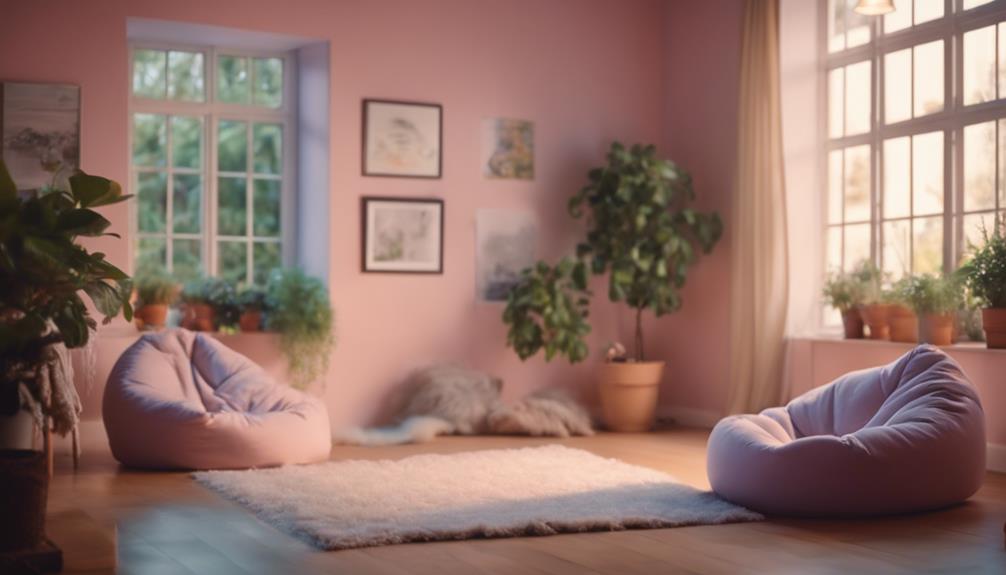You can fix your leather sofa by starting with regular maintenance. Clean it with a pH-balanced leather cleaner and apply a quality conditioner every 6-12 months to prevent drying and cracking. Keep your sofa out of direct sunlight and use protective sprays to shield it from UV damage. Check the stitching periodically for loose threads and tighten them as needed. If you notice fading or scratches, consider using color-matching dye for a seamless repair. Maintaining consistent humidity levels also prolongs its lifespan. Stay tuned for more effective tips to keep your leather sofa looking its best!
Key Takeaways
- Regularly inspect stitching and high-stress areas for loose threads, tightening as necessary to maintain structural integrity.
- Clean the leather thoroughly before applying any dye or conditioner to ensure proper absorption.
- Use color-matching leather dye to seamlessly blend repairs, applying multiple thin layers for evenness.
- Promptly address stains by blotting and using a vinegar-water solution or baking soda paste for effective removal.
- Condition leather every 6-12 months to restore moisture, enhance appearance, and extend the lifespan of your sofa.
Introduction
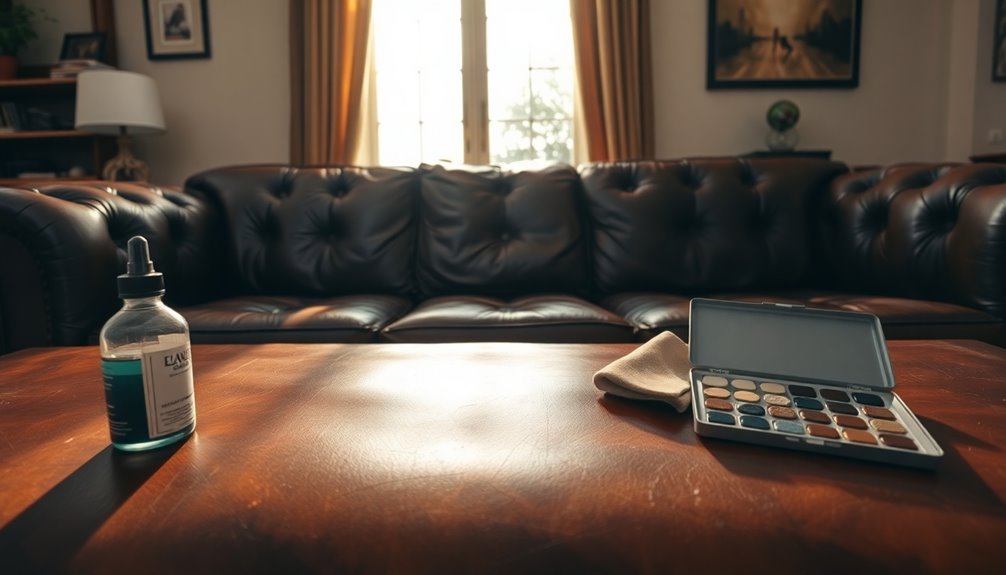
Keeping your leather sofa in top shape requires routine conditioning and the right cleaning techniques. You'll want to know how to tackle common issues like wine stains effectively. Let's explore the best practices to maintain your sofa's beauty and longevity.
Routine Leather Conditioning
Maintaining a leather sofa requires regular attention, and routine conditioning is key to preserving its beauty and functionality. To keep your leather furniture supple and prevent it from drying out or cracking, you should condition it every 6 to 12 months. This frequency largely depends on your climate and how often the sofa is used.
Before applying a high-quality leather conditioner, you'll want to clean the leather thoroughly with a gentle leather cleaner. This step removes dirt and oils that could hinder the absorption of the conditioner. Once the leather is clean, apply the conditioner specifically designed for your type of leather. This helps restore moisture and gives the surface a polished finish.
Regular conditioning not only enhances the appearance of your leather sofa but also increases its lifespan. By incorporating this cost-effective maintenance practice into your routine, you'll ensure your sofa remains a beautiful centerpiece in your home for years to come. Remember, a little care goes a long way in keeping your leather looking its best!
Fabric-Specific Cleaning Techniques
When it comes to cleaning your leather sofa, using the right techniques is crucial to avoid damage. Start by selecting pH-balanced cleaners designed specifically for leather. These products help maintain the leather's integrity without causing harm. Always test a small, inconspicuous area first to ensure compatibility with your leather type.
For routine cleaning, grab a soft, lint-free cloth and gently wipe the surface. Avoid harsh scrubbing, as this can lead to scratches or wear. If you encounter stubborn stains, a mixture of warm water and a few drops of mild soap can work wonders. Just remember to condition the leather afterward to restore moisture and prevent drying.
Regular cleaning with the appropriate products prevents the buildup of dirt and oils, keeping your leather looking fresh and prolonging its lifespan. If you ever find yourself facing more significant damage, consider leather repair techniques to restore your sofa's beauty. By following these fabric-specific cleaning techniques, you'll not only ensure your leather sofa remains in excellent condition but also enhance its overall appearance for years to come.
Wine Stain Removal Techniques
Accidents happen, and wine spills can be particularly daunting for your leather sofa. But don't worry; you can take quick action to repair leather and minimize damage. Start by blotting the wine stain immediately with a clean, dry cloth. This helps absorb excess liquid without rubbing, which could spread the stain further.
Next, mix equal parts white vinegar and water in a small bowl. Use a soft cloth to gently dab this solution onto the stain. Be cautious not to damage the leather. If the stain proves stubborn, create a paste using baking soda and water. Apply this mixture to the stain and let it sit for about 15 minutes before gently wiping it away.
Always remember to test any cleaning solution on an inconspicuous area of the leather first. After successfully removing the stain, finish the process by applying a leather conditioner. This step restores moisture to the leather and helps prevent cracking, ensuring your sofa looks its best. With these techniques, you'll be well-equipped to tackle wine stains and keep your leather sofa in great shape.
Avoiding Direct Sunlight
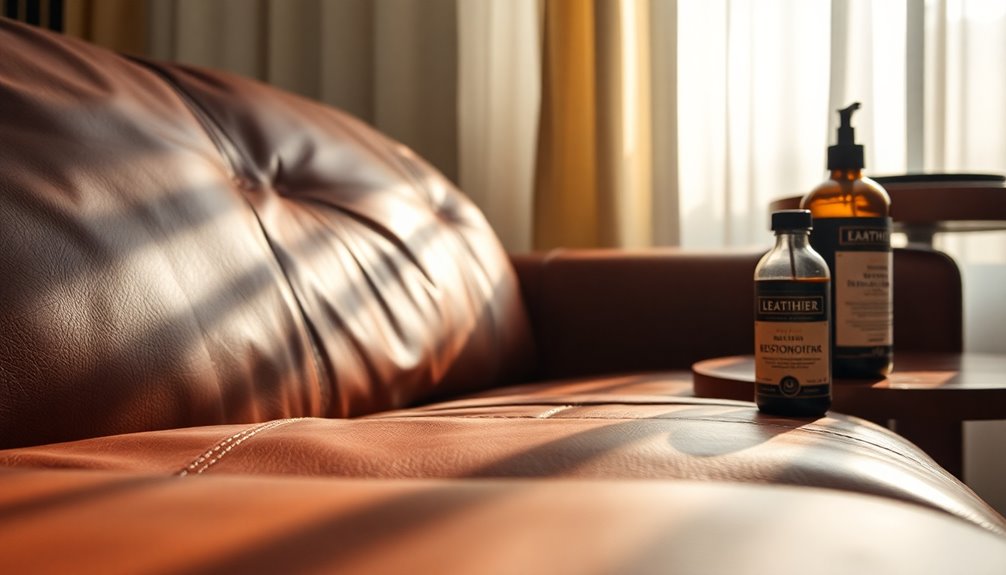
To keep your leather sofa looking great, you need to protect it from direct sunlight. Using scratch-resistant furniture sprays can help shield it from UV rays, while decorative throws add an extra layer of protection. Don't forget to regularly rotate cushions to ensure even wear and fading.
Scratch-Resistant Furniture Sprays
A scratch-resistant furniture spray can be a game-changer for maintaining your leather sofa's appearance and durability. These sprays create a protective barrier that reduces the likelihood of scratches and wear on your leather surfaces. Typically containing polymers, scratch-resistant furniture sprays bond to the leather, enhancing its durability against daily use, including the wear and tear from pets.
Regular application of these sprays can significantly extend the life of your leather furniture by preventing damage from friction and contact. To get the best results, be sure to follow the manufacturer's instructions regarding application frequency and method. This ensures you achieve optimal protection for your sofa.
However, keep in mind that the effectiveness of scratch-resistant sprays can diminish if your furniture is exposed to direct sunlight. Sunlight can break down the protective agents in the spray, leading to fading and decreased durability. So, if you want to maintain the longevity of your leather sofa, make it a point to store it away from direct sunlight whenever possible. By doing this, you'll preserve both the appearance and the protective benefits of scratch-resistant furniture sprays.
Decorative Throws for Protection
Decorative throws can be a stylish and practical solution for protecting your leather sofa from the damaging effects of direct sunlight. By placing these throws over your leather furniture, you effectively shield it from fading and deterioration caused by UV rays. This not only preserves the rich color and texture of the leather but also extends its life.
Choosing light-colored or UV-resistant decorative throws can maximize sun protection while enhancing your home decor. Additionally, these throws add a layer of defense against scratches and spills, ensuring your sofa maintains its aesthetic appeal. Make sure to select breathable fabrics for your throws; this allows air circulation, helping to prevent the leather from becoming overly warm and prone to cracking.
To keep your protective throws looking fresh and effective, regularly rotate and wash them. This simple maintenance step ensures they continue to serve their purpose while looking good in your space. By incorporating decorative throws into your home, you're not just protecting your leather sofa; you're also adding a touch of style and comfort to your living area.
Regularly Rotate Cushions
Regularly rotating your leather sofa cushions every few months helps distribute wear evenly and prevents uneven fading and sagging in high-use areas. This simple practice ensures that all parts of your sofa get equal use, maintaining its overall appearance and comfort.
In addition to cushion rotation, avoiding direct sunlight is crucial. Prolonged exposure can lead to leather fading, cracking, and deterioration. To protect your leather sofa, consider using curtains or blinds to block out harmful UV rays. You can also use protective covers or throws on your cushions when they're not in use, shielding them from sunlight and potential stains.
Remember to combine cushion rotation with regular maintenance, like conditioning and cleaning. This approach significantly extends the lifespan of your leather sofa, keeping it looking new for years to come. Not only will you enjoy a consistently comfortable seating experience, but you'll also preserve the beauty of your investment. By staying proactive with these simple care tips, you'll ensure your leather sofa remains a centerpiece of your living space, inviting you to relax in style without worrying about damage or wear.
Routine Stitching Checks
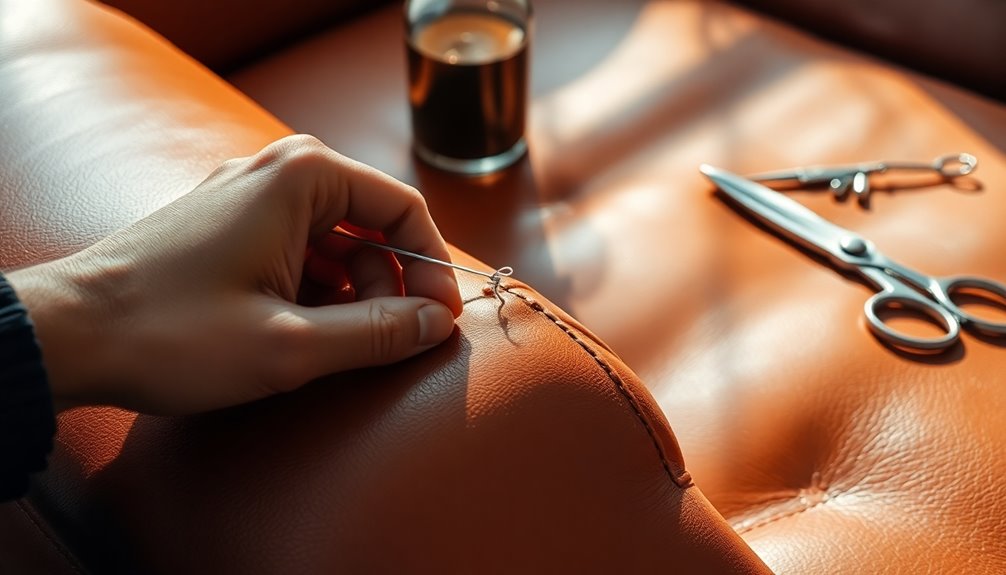
When you check the stitching on your leather sofa, you're not just looking for loose threads; you're ensuring the entire frame remains stable. Pay close attention to how the stitching interacts with the sofa's structure and cushioning, as any issues could affect your comfort. Noticing these details now can save you from bigger problems later.
Sofa Frame Stability Concerns
A leather sofa's comfort and style can quickly diminish if you overlook the importance of routine stitching checks. Regularly inspecting the stitching helps you identify any loose threads or fraying that could compromise the overall structure and stability of your sofa frame. Aim to conduct these checks every few months, especially in high-use areas like armrests and seat cushions, to catch early signs of wear.
When you notice any loose stitching, it's time for a repair. Use a strong upholstery thread and a sturdy hand quilting needle for the best results. Maintaining consistent tension while stitching is crucial; it prevents puckering, which can affect both the appearance and stability of your sofa.
Timely intervention in repairing loose stitching not only enhances the look of your sofa but also saves you the costs associated with more extensive professional repairs down the line. By staying proactive about routine stitching checks, you can significantly extend the lifespan of your leather sofa, ensuring it remains a centerpiece of comfort and style in your home.
Leather Color Matching Techniques
Achieving a seamless repair on your leather sofa requires careful attention to color matching techniques. First, choose a color-matching leather dye that closely resembles the original shade of your leather. This step is crucial for making the repaired area blend in seamlessly with the rest of the sofa. Before applying the dye to the damaged area, test it on a hidden spot to ensure it matches perfectly.
When you're ready to apply the dye, remember to use multiple thin layers instead of one thick coat. This method helps avoid uneven coloring and promotes better absorption into the leather. After applying the dye, blend the edges of the repaired area with a soft cloth. This technique softens the transition between the repair and the surrounding leather, enhancing the overall appearance.
Additionally, make it a routine to check the stitching and color of your leather sofa regularly. Keeping an eye out for any fading or wear allows you to identify issues early, making timely repairs and color matching much easier. By following these techniques, you can maintain the beauty of your leather sofa for years to come.
Cushioning for Enhanced Relaxation
Regularly checking your leather sofa's cushioning is essential for enhancing relaxation and comfort. Pay close attention to the stitching on the cushions; loose or frayed threads can lead to bigger problems if left unattended. Make it a habit to inspect the stitching at least every six months to maintain the integrity of your leather.
If you notice any issues, use upholstery thread and a sturdy hand quilting needle to repair a leather sofa effectively. When stitching, keep a consistent tension to avoid puckering, which can detract from both the appearance and comfort of your cushions. After completing any repairs, carefully inspect the area to ensure evenness and stability. This step is crucial for guaranteeing that your cushions remain comfortable and supportive.
Personalized Leather Color Treatments
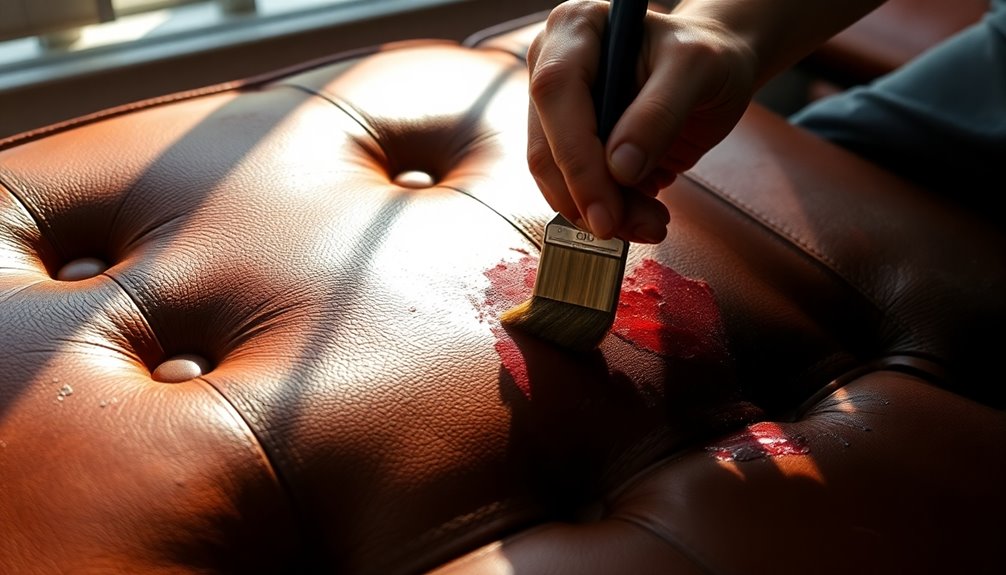
Personalized leather color treatments can breathe new life into your sofa, seamlessly blending with its original hue. Using color-matching dyes specifically formulated for leather, you can effectively restore faded areas and scratches. Before you start, make sure to clean the leather surface thoroughly. This step removes dirt and oils that could interfere with color adhesion.
When you're ready to apply the dye, consider using a leather repair kit that often comes with an applicator sponge or brush. This tool gives you precise control over the amount of dye you use, allowing for an even application across the surface. Take your time, applying the dye carefully to ensure a seamless finish.
After applying the dye, it's crucial to condition the leather. Conditioning restores moisture and helps maintain the integrity of your color treatment, preventing future cracking. With these personalized treatments, your leather sofa can regain its original charm, making it look as good as new. By investing a little time and effort, you'll enjoy a refreshed sofa that enhances your living space.
Seasonal Humidity Control Tips
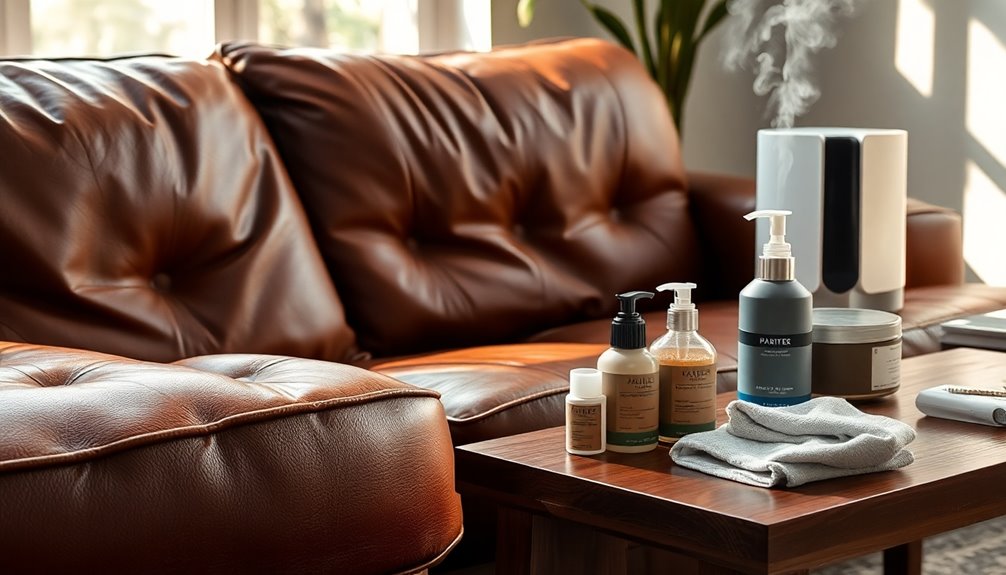
To keep your leather sofa in top shape, controlling humidity is essential, especially as the seasons change. Aim to maintain indoor humidity levels between 30-50%. This balance prevents your leather from drying out or becoming overly moist, which can lead to mold growth.
During humid months, using a dehumidifier can significantly help by reducing excess moisture in the air. This step is crucial for preserving the integrity of your leather furniture. Conversely, in dry seasons, a humidifier can add much-needed moisture back into the air, preventing your leather from cracking and losing its suppleness.
Regularly check your indoor humidity with a hygrometer to ensure optimal conditions for leather maintenance. If you need assistance with this, feel free to reach out via your email address. Additionally, avoid placing your leather furniture near heat sources like radiators or air vents; they create uneven humidity levels that could damage your sofa.
Conclusion
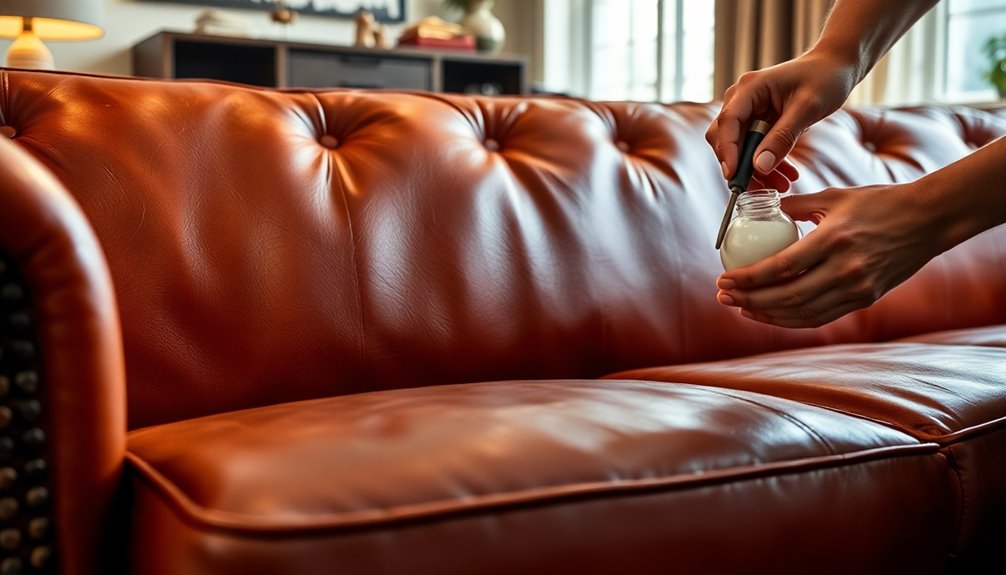
Maintaining the right humidity levels is just one part of keeping your leather sofa in great condition. Regular maintenance and prompt repairs play a crucial role in extending its lifespan. By addressing minor damages quickly, you can prevent them from escalating into larger issues that may require costly fixes.
When tackling scratches and tears, use appropriate tools and materials, like leather repair glue and color-matching dyes, to ensure effective DIY repairs. However, if you encounter significant damage, don't hesitate to seek professional assistance. They'll guarantee repairs are done correctly, preserving your sofa's integrity.
Additionally, keep your leather sofa conditioned and shielded from direct sunlight to maintain its appearance and prevent future damage. Don’t forget to utilize community resources and online guides for valuable support and tips throughout your repair projects. Moreover, regular cleaning with a damp cloth and a designated leather cleaner can help preserve the material’s integrity. When researching how to maintain leather furniture, you might find helpful tutorials and videos that demonstrate proper techniques. Engaging with local workshops or forums can also provide valuable insights, ensuring your leather pieces remain beautiful for years to come.
Frequently Asked Questions
Can You Repair a Damaged Leather Sofa?
Yes, you can repair a damaged leather sofa, especially if the damage is minor, like scratches or small tears. You'll want to gather some essential tools, such as leather repair glue and color-matching dye. For larger tears, consider using a leather patch, securing it with adhesive, and then filling and dyeing it to blend in. Regular maintenance will help keep your sofa looking great and make future repairs easier. Don't hesitate to seek professional help if needed!
Do Leather Repair Kits Actually Work?
Yes, leather repair kits can work effectively for minor damages like scratches and small tears. They come with color-matching fillers and tools that help you achieve a seamless finish. If you follow the instructions closely, you're likely to see satisfactory results. However, keep in mind that while they can improve the appearance, they might not fully restore the original texture of the leather, especially for more extensive damages.
How to Fix a Peeling Leather Couch?
To fix a peeling leather couch, start by cleaning the affected area with a leather cleaner to remove dirt. Trim away any loose pieces to create a smooth surface. Next, apply a leather repair compound, ensuring you cover all gaps evenly. Once it's dry, gently sand the area with fine-grit sandpaper for a smooth finish. Finally, condition the repaired section with leather conditioner to restore moisture and prevent future peeling.
Is It Worth It to Reupholster a Leather Sofa?
When you're considering whether it's worth it to reupholster a leather sofa, think about its condition and sentimental value. If the frame's sturdy and you love the piece, reupholstering can breathe new life into it. It's a cost-effective option compared to buying new, plus it's environmentally friendly. You'll save money long-term and keep your cherished sofa while enhancing its look and functionality. Ultimately, it's a decision that reflects your priorities.
